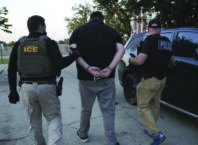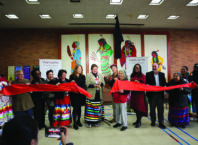
By Associated Press
Voter participation advocate Theresa Pasqual traverses the tribal community of Acoma Pueblo with a stack of sample ballots in her car and applications for absentee ballots, handing them out at every opportunity ahead of New Mexico’s June 4 primary.
Residents of the pueblo’s original mesa-top “sky city” that endured after the Spanish invasion in the late 1500s know firsthand the challenges that Native American voters have faced across Indian Country, where polling places are often hours away and restrictive voter laws and ID requirements only add to the barriers.
It’s been a century now since an act of Congress granted citizenship to Native Americans, but advocates say that birthright bestowed in 1924 still hasn’t translated into equal access to the ballot. Inequities are especially pronounced in remote regions across the U.S., and some key Southwestern states with large Native American populations.
New Mexico is trying something new — a test run of sorts for many new and contested provisions that are part of the state’s Native American Voting Rights Act that was passed last year. The measure promises tribal communities a greater voice in how and where they can vote, even opening the possibility that tribal offices can be designated as a street address for remote households that have none.
This should help at Acoma, where Pasqual said some residents still live in a village where standard addresses do not exist.
Native Americans in New Mexico — home to 22 federally recognized tribal communities and holdings of an Oklahoma-based tribe — were among the last to gain access to voting, decades after the U.S. extended birthright citizenship to the land’s original inhabitants on June 2, 1924 through the Indian Citizenship Act.
That legislation took shape in the aftermath of World War I in which thousands of Native Americans had volunteered to serve overseas in the military.
A patchwork of statutes and treaties already offered about two-thirds of Native Americans citizenship, sometimes in exchange for land allotments that fractured reservations, gestures of assimilation, military service and even the renunciation of tribal traditions. The one-sentence Indian Citizenship Act swept away those requirements in an attempt to grant citizenship to all Native Americans.
At the same time, Congress deferred to state governments on who would be qualified to vote. Legal access to the ballot was denied under existing state constitutional provisions and statutes until 1948 in Arizona and New Mexico — and until 1957 on reservations in Utah.
It was by design, said Maurice Crandall, an Arizona State University history professor and citizen of the Yavapai-Apache Nation of Camp Verde. Pointing to the largest Native populations in New Mexico and Arizona, he said: “They don’t want a large group of Native people who can swing elections.”
Fast forward to 2020, he said, and “many people credit the Native vote with deciding to bring Arizona into the (Joe) Biden camp.”
Biden won Arizona by about 10,500 votes, as voter turnout surged on the Navajo and Hopi reservations.
At Laguna Pueblo in New Mexico, voting has provided Native Americans with a path to power amid the political rise of pueblo member Deb Haaland. She became one of the first two Native American women in Congress in 2018 before taking the reins of the Interior Department to oversee U.S. obligations to 574 federally recognized tribes.
For the upcoming primary, Laguna is on the front lines of two Democratic contests with first-time female Native American candidates competing in districts that were redrawn in 2021 to increase Native American influence. In the general election, eligible voters among 8,000 Laguna residents will cast ballots in a congressional swing district rematch between U.S. Rep. Gabe Vasquez and Republican Yvette Herrell, who lost in 2022 by 1,350 votes. Herrell seldom invokes her Cherokee heritage.
The state’s new voting rights legislation for Native Americans provides new tools for tribal communities to request convenient on-reservation voting sites and secure ballot deposit boxes with consultation requirements for county clerks and an appeals process.
But there are still obstacles, said Laguna Pueblo tribal administrator Ashley M. Sarracino, pointing to tensions with county election administrators over a decision to withdraw three Election Day voting sites at the pueblo this year, leaving three open.
In Arizona, the anniversary of the Indian Citizenship Act stirs up frustration among Native American leaders, including Gov. Stephen Lewis of the Gila River Indian Community. He has denounced efforts by the Republican National Committee and state lawmakers to revive and extend voter ID requirements through the 2024 general election.
It was two members of Lewis’ community who sued in 1928 after being turned away from the polls, only to have the Arizona Supreme Court rebuff their case. The community wouldn’t realize the right to vote until 1948 — after World War II and the raising of an American flag at Iwo Jima that included Ira Hayes, who was part of the Gila River community.
Lewis during a recent online forum counted the years that passed between the time the U.S. Declaration of Independence was inked and the Indian Citizenship Act was signed. He said elected officials for years have “made laws for us, about us, but never with us.”
Native Americans have held widely divergent views about citizenship and voting, said Torey Dolan, a research fellow at the University of Wisconsin Law School and citizen of the Choctaw Nation of Oklahoma. Some view U.S. citizenship as incompatible with being Indigenous people; others see it more like dual citizenship.
With approval of the citizenship act, many Native Americans feared the expansion of U.S. citizenship might undermine the special status of trust land that allows tribes to make their own decisions about tax-exempt land and shield it from speculators.
“It was really seen in many parts of Indian Country as being aimed at breaking down tribal cultures, particularly in the Southwest,” said Geoffrey Blackwell, general counsel to the National Congress of American Indians that advocates for Native American rights and sovereignty.
For some, ensuring voting rights was worth the fight. In 1948, Isleta Pueblo member and World War II military veteran Miguel Trujillo challenged the status quo that barred Native Americans in New Mexico from voting by attempting to vote in Valencia County. He was rejected, sparking a landmark lawsuit that was supported by Washington-based federal Indian law pioneer Felix Cohen and the National Congress of American Indians.
A 1956 federal survey of Native voting in the Southwest found anemic participation, with no polling places set up at New Mexico pueblos. In Arizona, Jim Crow-style discrimination set in with widespread application of literacy tests to block Native-language speakers from voting until the practice was barred in 1970 under the federal Voting Rights Act.
The Voting Rights Act of 1965 spurred a new movement within tribal communities to encourage participation, said Laura Harris, the Albuquerque-based director of Americans for Indian Opportunity and a citizen of the Comanche Nation of Oklahoma.
In 2013, the U.S. Supreme Court struck down a key provision of the Voting Rights Act that gave the Justice Department election oversight in states with a history of discrimination. Since then, several states have enacted new voting laws that some legal experts say make it unreasonably difficult for Native Americans to vote, including a flurry of restrictions from Republicans enacted in the wake of the 2020 election.
But in New Mexico, the Sandoval County clerk’s office has expanded early voting services in recent years for Navajo and pueblo communities. Only one pueblo declined the opportunity this year. Native language interpreters are posted at each of the sites, which are open to all county residents.
Evelyn Sandoval works with the county attorney’s office as a liaison to Native Americans. She teaches families how to use newly available tools to register online and receive absentee ballots by mail.
“I’m trying to get them to be self-reliant,” said Sandoval, a 54-year-old former oil and gas company worker who was raised Ojo Encino, a Navajo community with fewer than 300 residents. Her mother spoke only Navajo.






